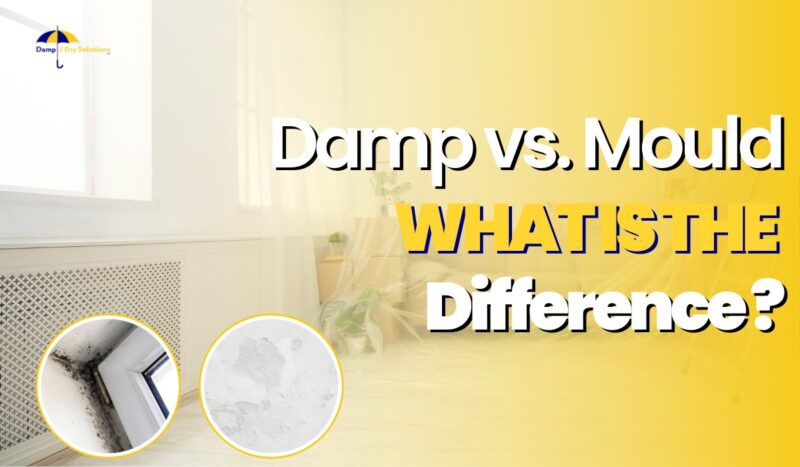
In a world where home-related issues can leave us baffled, the fine line between dampness and mould often blurs. Homeowners frequently grapple with the confusion of these two terms, wondering if they are indeed the same. Are mould and damp the same thing? Let’s break it down, shall we?
Understanding Damp: A Common Household Intruder
Damp, a pervasive household concern, is a term that homeowners often encounter. It refers to the presence of excess moisture within a building, and its effects can be both unsightly and detrimental.
Dampness in homes typically arises from several sources, including condensation, penetrating damp, and rising damp. Each of these has distinct characteristics:
- Condensation: One of the most common causes of dampness, condensation occurs when warm, moist air meets cold surfaces, leading to the formation of water droplets. This often happens in bathrooms and kitchens, where high humidity levels are prevalent.
- Penetrating Damp: This type of damp occurs when water from external sources, such as rainfall, penetrates the building through damaged or poorly constructed walls, roofs, or windows. Penetrating damp can manifest as wet patches on walls and ceilings.
- Rising Damp: Rising damp is a result of capillary action, which draws groundwater up through a building’s walls. It primarily affects ground-level walls and can lead to visible damp patches and damage to plaster and paint.
Dampness not only affects the aesthetics of your home but can also have several adverse consequences. It can cause peeling paint, discoloured walls, and unsightly watermarks. Furthermore, it can create an unhealthy living environment by fostering the growth of mould and mildew.
The Health Implications of Dampness

A home’s interior moisture problems can have a significant negative impact on the health of its residents in addition to being an aesthetic concern. Excessive moisture in indoor spaces, whether caused by condensation, penetrating damp, or rising damp, can lead to various health problems. In short, can dampness make you ill? The answer is Yes.
Damp environments foster the growth of mould, which releases spores into the air. Inhaling these mould spores can trigger respiratory issues, allergies, and skin irritation. Individuals with pre-existing conditions like asthma may experience worsened symptoms in such surroundings.
Dampness can also contribute to a generally uncomfortable living environment, potentially leading to more frequent illnesses and an overall decline in well-being.
Unveiling Mould: The Unwanted Houseguest
Mould, a term that sends shivers down the spine of homeowners, is a common household problem. It is a type of fungus that thrives in damp, humid conditions and is often found in homes. Here’s a closer look at what mould is and why it’s a cause for concern.
It appears as unsightly patches of fungal growth on various surfaces, such as walls, ceilings, and even fabrics. It can take on various colours, including green, black, or grey. Mould often carries a musty and unpleasant odour.
Mould thrives in environments with excess moisture and humidity. It is a consequence of dampness, making it closely related to issues like condensation, penetrating damp, and rising damp. When dampness remains unchecked, it provides the ideal conditions for mould spores to germinate and multiply.
Preventing and Addressing Mould
The most effective way to deal with mould is to address its underlying cause: dampness. Here are some steps to prevent and manage mould.
- Control Indoor Humidity: Maintain indoor humidity levels below 50% to inhibit mould growth. Proper ventilation is key to achieving this.
- Fix Dampness Issues: Address the source of dampness, whether it’s condensation, penetrating damp, or rising damp. Fix leaks, improve insulation, and maintain a dry environment.
- Mould Removal: If mould has already taken hold, it’s crucial to clean and remove it properly. Use appropriate cleaning agents and take precautions to prevent the spread of spores.
- Identify and fix leaks: Mould needs moisture to grow, so it’s important to identify and fix any leaks in your home as soon as possible. This includes checking your roof, gutters, plumbing, and appliances for any signs of water damage.
Mould is not only unsightly but can also be harmful to both your home and your health. Scroll down to learn more about it.
Mould’s Impact on Health
Mould, often lurking in damp or humid environments, poses significant health concerns.
Exposure to mould spores can result in a range of adverse health implications. Inhalation of these microscopic spores can lead to respiratory problems, allergies, and skin irritation. For individuals with asthma or compromised immune systems, mould can exacerbate existing conditions. Prolonged exposure may even cause severe lung infections.
Additionally, the presence of mould can result in an overall decrease in indoor air quality, leading to a decline in overall well-being. To safeguard health, it’s imperative to address mould issues promptly and create a mould-free living space.
The Difference Between Damp and Mould
Dampness primarily relates to the presence of excessive moisture within the building. It can manifest as wet patches on walls, ceilings, and floors. It is the result of various factors, including condensation, penetrating damp, and rising damp.
On the other hand, mould is a specific consequence of dampness. It is a type of fungus that thrives in damp or humid conditions. Mould appears as unsightly patches of green, black, or grey on surfaces, accompanied by a musty odour. This growth occurs when dampness remains unchecked and provides an ideal breeding ground for mould spores.
Key Difference Between Mould and Damp
is damp and mould the same thing? Damp and mould aren’t the same thing, although they are closely related. Damp is essentially the buildup of moisture within a building, which can appear as wet patches, staining, peeling wallpaper or paint, and a musty smell. Mould, on the other hand, is a type of fungus that thrives in these damp conditions. So, while damp refers to the moisture itself, mould is what can develop if that moisture isn’t properly managed.
Understanding the difference between the two is important because each requires different treatments and approaches. Knowing whether you’re dealing with damp or mould can save you time, effort, and money in the long run. Here’s how they differ:
- Root Cause: Dampness results from excessive moisture within a building, whereas mould is the visible consequence of unchecked dampness.
- Appearance: Dampness typically presents as wet patches or water damage on surfaces, while mould is characterised by its fungal growth, with various colours, on affected areas.
- Health Implications: Dampness can lead to respiratory issues, allergies, and a generally uncomfortable living environment. Mould, however, poses more severe health risks, as inhaling mould spores can lead to respiratory problems and allergic reactions.
Here is the difference at a glance
| Aspect | Dampness | Mould |
| Definition | Excessive moisture within a building | Type of fungus that thrives in damp, humid conditions |
| Appearance | Wet patches or water damage on surfaces | Unsightly patches of fungal growth on various surfaces |
| Causes | Condensation, penetrating damp, rising damp | Result of unchecked dampness and high humidity |
| Health Implications | Can lead to respiratory issues, allergies, and discomfort | Inhalation of mould spores can cause respiratory problems, allergies, and skin irritation |
| Prevention | Proper insulation, ventilation, and fixing leaks | Address the source of dampness, maintain low humidity, and proper mould removal |
| Common Areas Affected | Walls, ceilings, floors, and basements | Walls, ceilings, fabrics, and any damp environment |
| Odour | Typically no specific odour | Often accompanied by a musty or unpleasant smell |
| Immediate Action Required | Yes, to prevent further damage | Yes, to prevent health issues and further growth |
Preventing and Addressing Dampness and Mould Issues
Now that we’ve clarified the differences between dampness and mould, let’s discuss how to prevent and address these concerns.
Preventing Dampness
- Proper insulation and ventilation are key to preventing dampness caused by condensation.
- Regularly inspect your property for leaks and fix them promptly to avoid penetrating damp.
- Ensure your home’s damp-proof course is intact to prevent rising damp.
Addressing Mould
- To tackle mould issues, start by eliminating the source of dampness.
- Clean and remove mould from surfaces using appropriate cleaning agents.
- Improve ventilation and maintain indoor humidity levels below 50% to inhibit mould growth.
Conclusion
Dampness and mould are not one and the same; they are related but distinct issues. Dampness is the underlying problem caused by excess moisture, while mould is the visible outcome of unchecked dampness. Understanding these differences is crucial for effective prevention and management. By taking proactive measures, homeowners can create a healthier and more comfortable living environment.
Need Help?
Discover a healthier, mould-free living environment with Damp2Dry Solutions Ltd. Our expert services are tailored to prevent and tackle dampness and mould, ensuring your home remains safe and comfortable.
Say goodbye to unsightly patches and health concerns – choose Damp2Dry for a damp and mould-free future.
